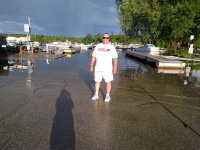John -
Why do we see the levels of the Great Lakes fluctuate over time yet precipitation measurements do not correlate to those cycles? Or do they and I'm just not using my data correctly?
I would think that rain/snow amounts would directly impact water height of Superior or Huron, but that does not appear to be the case over time. Is this due to evaporation/sequestering that prevents that precipitation from reaching/impacts the lakes or?
Water Level Data:
https://www.lre.usace.army.mil/Miss...n/Great-Lakes-Information-2/Water-Level-Data/

Question 2
What's a good site for historical precipitation data, for MI, say from 1900 to present? Sites like MSU seem to have incomplete data sets for historical info:
https://climate.geo.msu.edu
PS - while doing some research, one of the "weather" sites had this to say about MI, clearly the authors were not sledders:
The worst time to visit Michigan is the severely cold winter season from December to February. The northern highlands of the Upper Peninsula and areas near Lake Superior see snowfall in excess of 150" (3810mm). Snowstorms affect normal life and damage life and property.
Why do we see the levels of the Great Lakes fluctuate over time yet precipitation measurements do not correlate to those cycles? Or do they and I'm just not using my data correctly?
I would think that rain/snow amounts would directly impact water height of Superior or Huron, but that does not appear to be the case over time. Is this due to evaporation/sequestering that prevents that precipitation from reaching/impacts the lakes or?
Water Level Data:
https://www.lre.usace.army.mil/Miss...n/Great-Lakes-Information-2/Water-Level-Data/

Question 2
What's a good site for historical precipitation data, for MI, say from 1900 to present? Sites like MSU seem to have incomplete data sets for historical info:
https://climate.geo.msu.edu
PS - while doing some research, one of the "weather" sites had this to say about MI, clearly the authors were not sledders:
The worst time to visit Michigan is the severely cold winter season from December to February. The northern highlands of the Upper Peninsula and areas near Lake Superior see snowfall in excess of 150" (3810mm). Snowstorms affect normal life and damage life and property.

